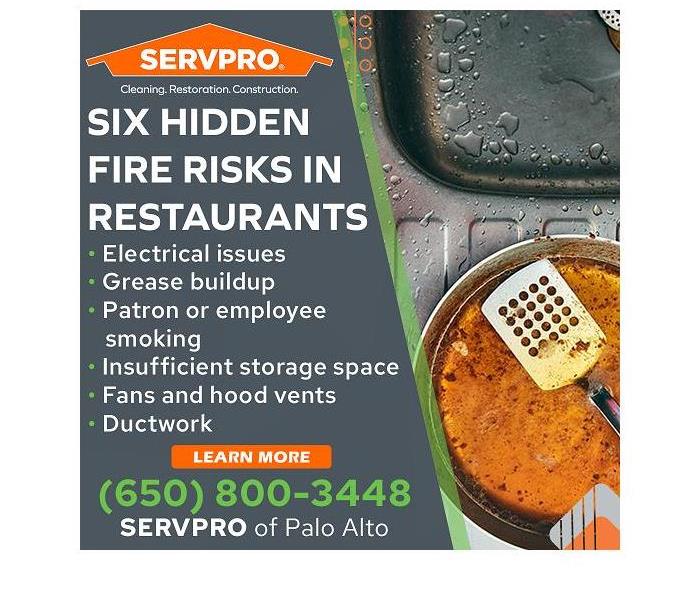Six Hazards That Can Lead to Fire Damage at Restaurants in Sunnyvale, CA
5/16/2022 (Permalink)
Blog Summary: SERVPRO of Palo Alto highlights six hidden fire risks that may be present in a restaurant setting.
Fire and water damage restoration services are urgently needed when a Sunnyvale, CA, business experiences property damage from fire and the efforts to extinguish the blaze. A fire at a commercial facility, such as a restaurant, can be very costly and can potentially put the business out of business.
Restaurants are especially vulnerable to fire damage and its expensive aftermath. McGowan Program Administrators, a leading writer of insurance programs, shares the following statistics: “During a four-year study by the National Fire Protection Association (NFPA), there were 7,640 structural fires in dining and drinking establishments. These fires caused more than $246 million in property damage. According to the Federal Emergency Management Agency (FEMA), the average loss for a commercial kitchen fire is $23,000. Of those, FEMA reports 43% were a total loss, forcing the restaurant to close.”
Within a restaurant, the stove and cooking equipment are the most obvious sources of fire damage. However, restaurant owners and their employees also need to be aware of fire hazards that are less apparent as causes of and contributors to fire damage.
Six Hidden Fire Risks in Restaurants
Electrical issues
The kitchen is not the only place that a restaurant fire can originate from. An electrical fire can occur anywhere in the building and could be caused by frayed electrical or extension cords, damaged outlets, overloaded circuits, aging wiring, or malfunctioning equipment.
Grease buildup
Any place where grease could accumulate should be checked and cleaned regularly. Grease traps, exhaust systems, and wood-burning ovens all create the potential for grease buildup. The National Fire Protection Association (NFPA) provides the following maintenance and inspection requirements:
- Grease traps: Clean four times yearly for a high-volume restaurant or two times yearly for a lower-volume restaurant
- Exhaust system: Inspect the system four times yearly for a high-volume restaurant or two times yearly for a lower-volume restaurant
- Wood-burning ovens or other methods of solid fuel cooking: Inspect the unit monthly
Never use water to extinguish a grease fire since grease tends to splatter when it comes in contact with water. Splashing grease can cause the fire to spread.
Patron or employee smoking
When diners, staff, or vendors discard cigarettes inside a trash can, a fire could break out. Make sure that smoking receptacles are available outside the building, and if the restaurant allows its staff to smoke, establish a designated smoking area equipped with the proper cigarette disposal units.
Insufficient storage space
When a restaurant does not have enough room to store supplies, items tend to overflow into the cooking area. Never keep flammable materials near heat sources or cooking equipment; instead, store flammable substances and items securely and away from heat or open flames. Investing in more storage space or better storage solutions is far less expensive than the cost of property damage loss and restoration.
Fans and hood vents
Commercial kitchen hood and fan systems pull flammable vapors into the exhaust system. It is recommended that hood vents be cleaned on a nightly basis.
A restaurant equipment supplier advises, “All parts of your ventilation system must be regularly cleaned. This includes the hood, hood filters, ductwork, and upblast exhaust fan. If any one part of your kitchen hood system is dirty, it will have a domino effect on the rest of it, causing it to work inefficiently and eventually break down.”
Ductwork
If a fire starts in a restaurant, the ductwork, including the HVAC system, will spread the fire quickly. Also, ductwork tends to capture flammable grease, which can exacerbate the blaze.
Restaurants are advised to keep the correct types of fire extinguishers on hand to put out different types of fires. For instance, a combustible fire requires the use of a different extinguisher than an electrical fire.
In the event that fire damages a restaurant in Sunnyvale, CA, the restaurant owner can turn to SERVPRO of Palo Alto for commercial restoration services. The full-service damage restoration company can address the initial fire damage, as well as any water damage or mold. The team can also effectively remediate smoke odors. Once SERVPRO of Palo Alto has completed the restoration process, the restaurant will be safe, clean, and ready to reopen to diners.
For more information about fire damage restoration in Sunnyvale, CA, email SERVPRO of Palo Alto at office@SERVPROpaloalto.com. The office can also be reached by phone at (650) 800-3448.



 24/7 Emergency Service
24/7 Emergency Service
